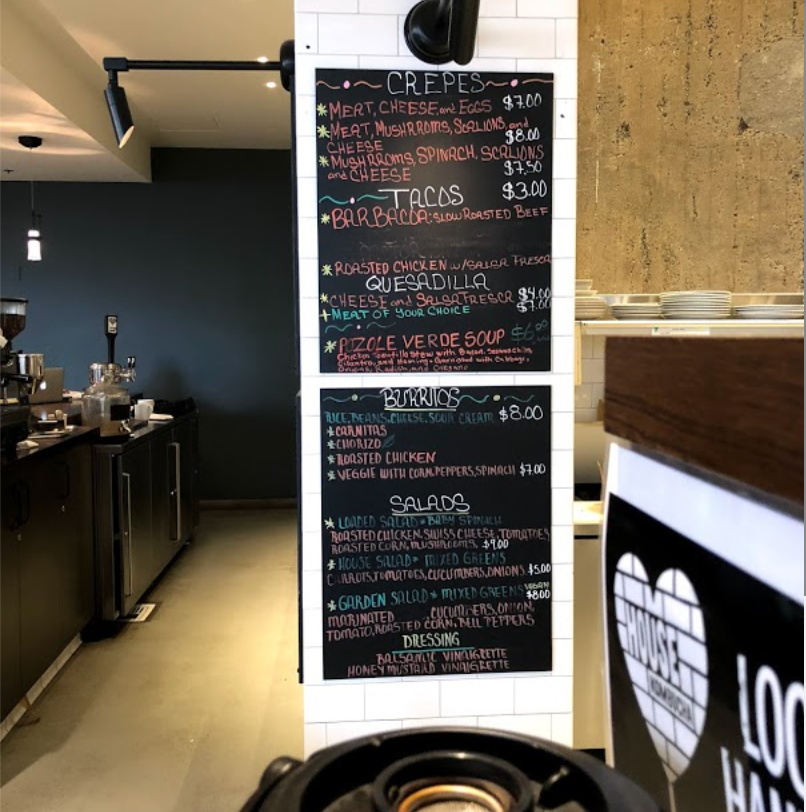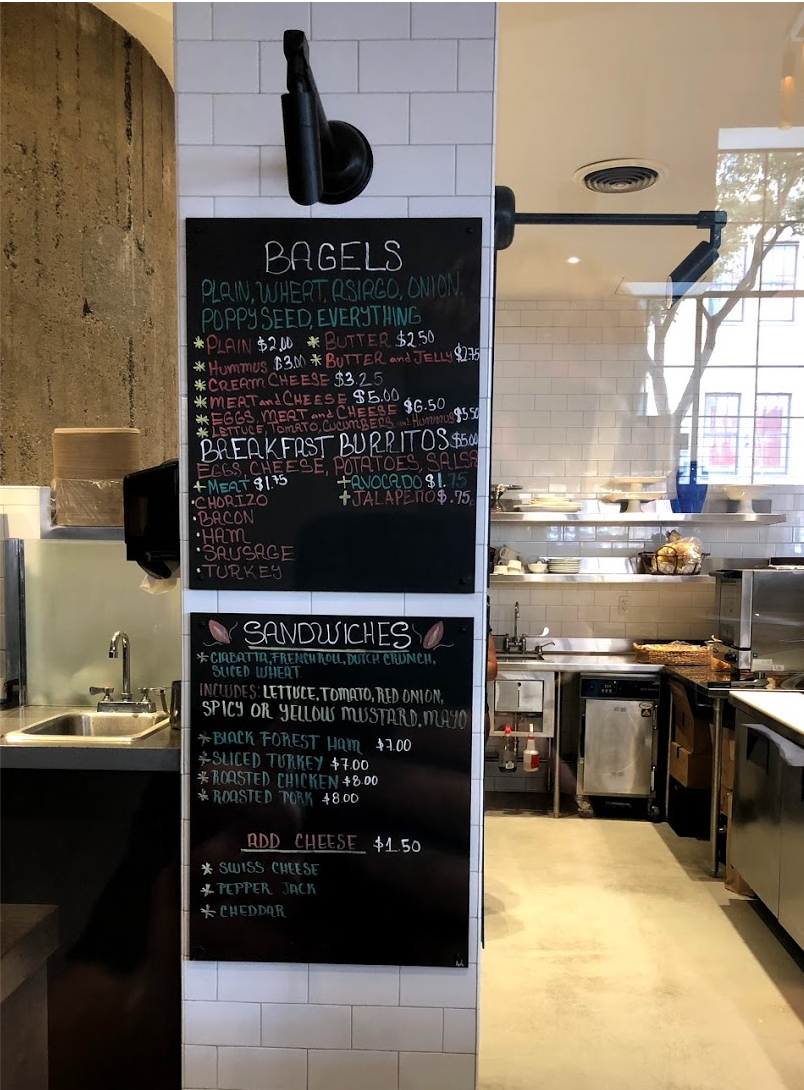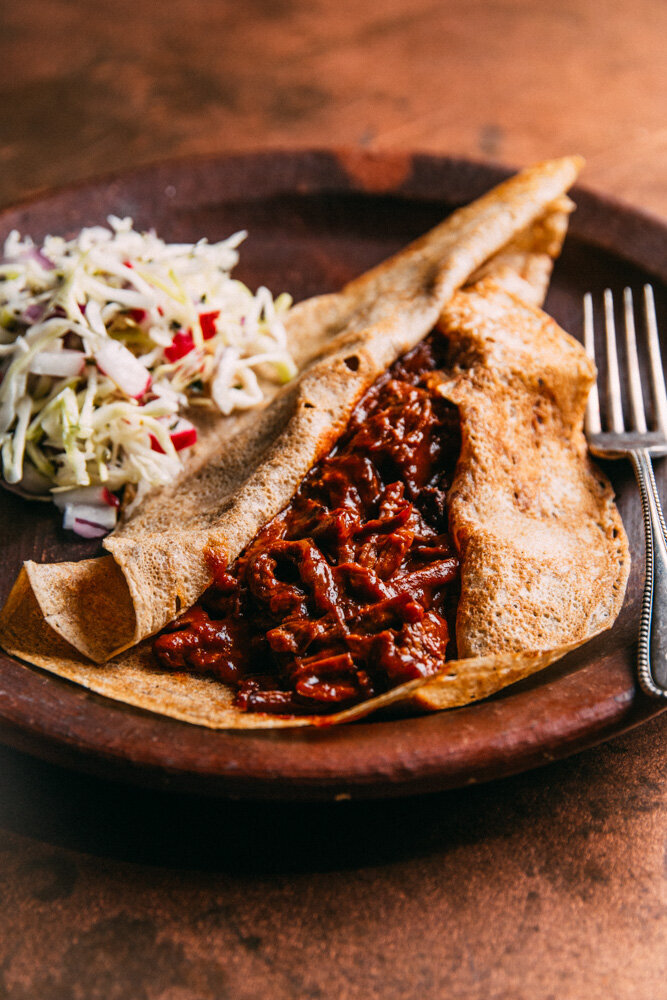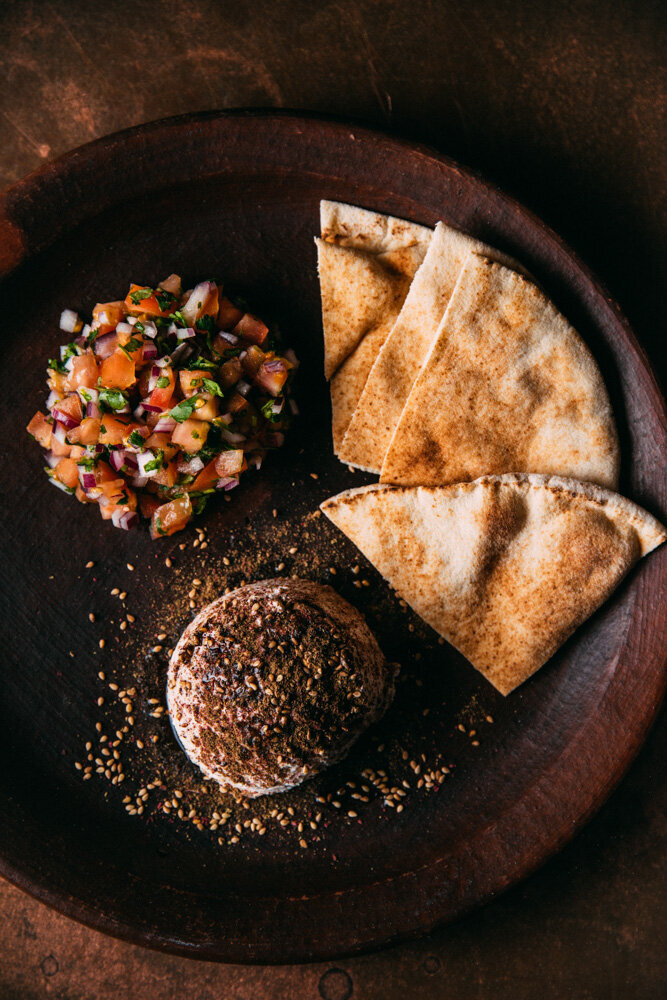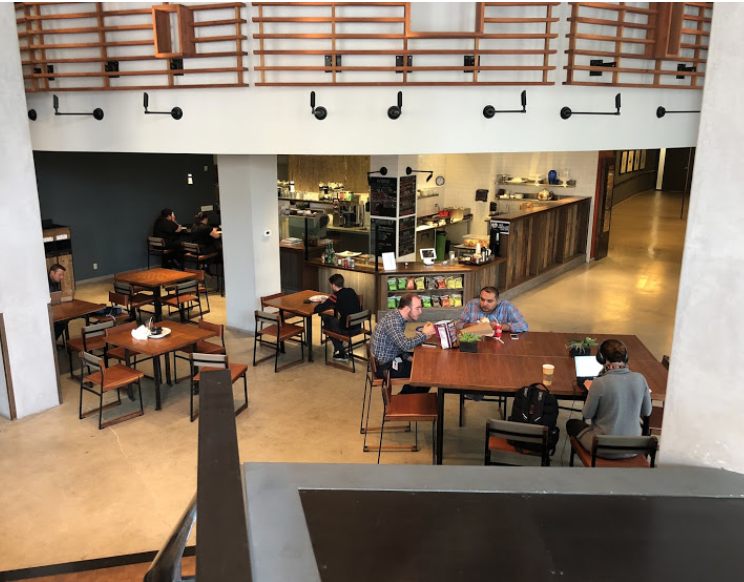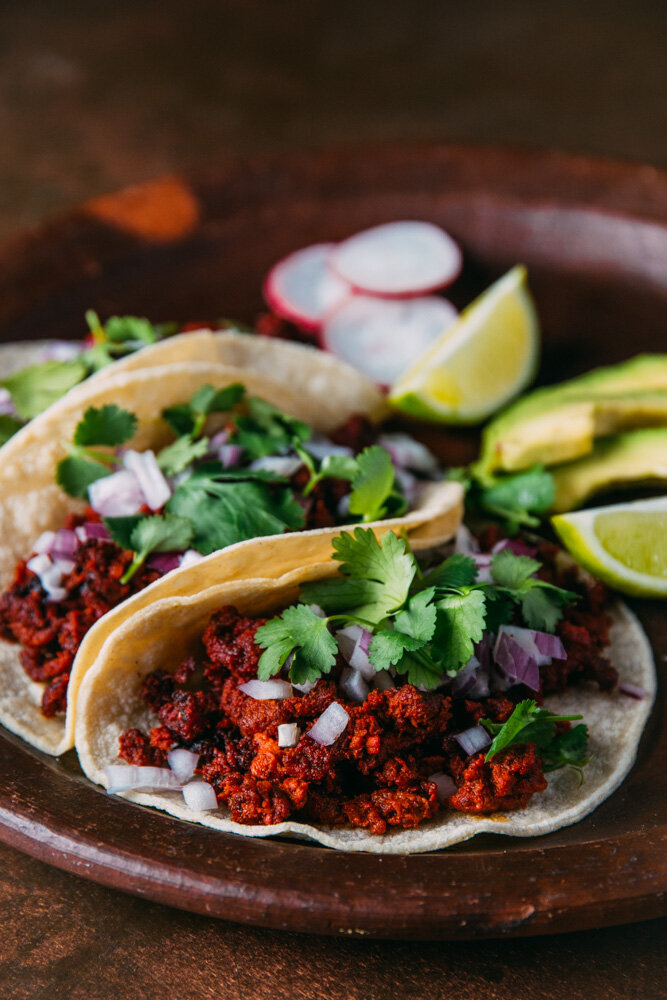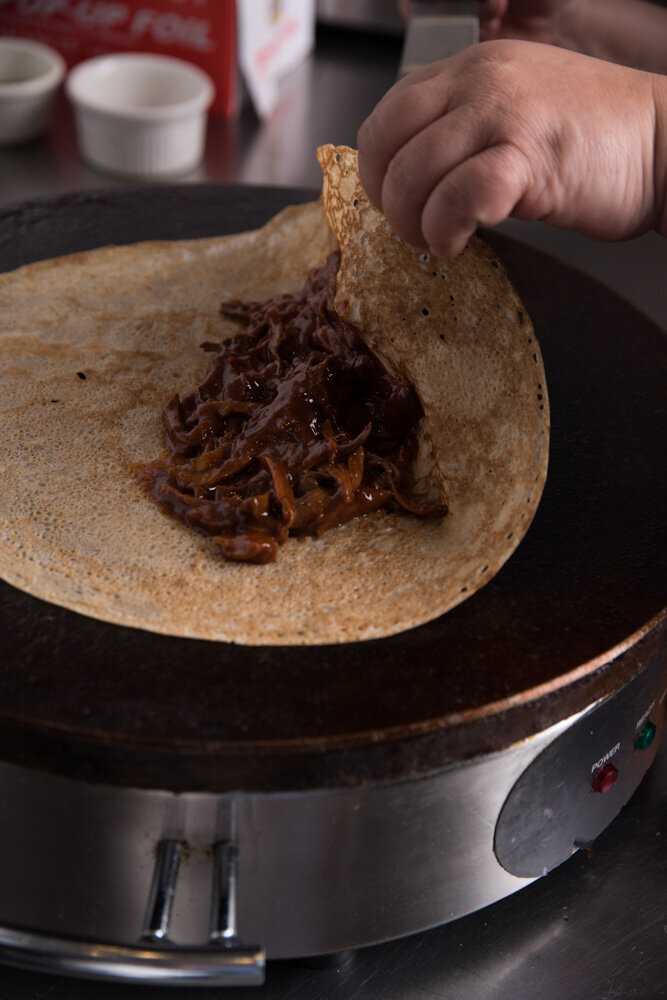Gabriela Guerrero shares journey to Delicioso Crêperie and her connection to holiday tamales
By Jessie Wesley, Mateo Rojas, and Maddie Scher
Gabriela Guerrero is the chef and owner of Delicioso Crêperie, a cafe that combines the French influence of crepe making with Gabriela’s Mexican background. Her cafe is supported by La Cocina, a nonprofit that supports business ownership for women, immigrants and people of color. Jessie Wesley, a Program Manager at SF New Deal, connected with Gabriela to hear the story of Delicioso Crêperie, the experience of navigating COVID-19 as a small business owner, and her personal connection to celebrating the holidays with tamales: “Apart from the fact that it is a dish that comes with the history of corn and how they make them, in Mexico it is also a way to bring the family together and prepare them. It's a gathering to make tamales. In large families, the mother is cooking one thing, the son is grinding the corn, the young children are putting dough in the corn husks; it is a form of coming together for Christmas dinner. I have memories of my family doing all that.” You can find Gabriela’s tamale recipe at the bottom of her interview. The English translation of this interview follows the Spanish.
Gabriela Guerrero es la cocinera y dueña de Delicioso Crêperie, un café que combina la influencia francesa de hacer crepes con el origen mexicano de Gabriela. Su café es respaldado por La Cocina, una organización sin fines de lucro que apoya la propiedad de negocios para mujeres, inmigrantes, y la gente de color. Jessie Wesley, una gerente de programa de SF New Deal, contactó a Gabriela para oír la historia de Delicioso Crêperie, la experiencia de navegar el COVID-19 como dueña de negocio pequeño y su conexión personal de celebrar los días festivos con tamales: “Aparte de que es un platillo que viene con historia del maíz y como lo hacen, también en México es una forma de juntar a la familia y prepararlos. Es una reunión hacer tamales. En familias grandes mientras la mamá pone a cocer algo, el hijo prepara la masa, los niños chiquitos ponen masa a las hojas; es una forma de reunión para la cena de Navidad. Yo tengo memorias de mi familia haciendo todo eso.” Puede encontrar la receta de tamales de Gabriela al final de la entrevista. La traducción al inglés de esta entrevista sigue al español.
¿Me puede decir tu nombre y también me puede decir qué le inspiró abrir Delicioso Crêperie?
Mi nombre es Gabriela Guerrero soy de la Ciudad de México. El nombre de mi negocio es Delicioso Crêperie. En México mi profesión es cosmetología, pero mi pasión por la comida empezó como a los quince años.
Crecí con ciertas comidas tradicionales mexicanas y mis papás viajaban mucho, entonces en mi casa había comida mexicana, comida española porque tengo familiares españoles, comida libanesa porque también tengo familia libanesa, comida alemana y comida francesa. Mi vida fue influenciada por muchos tipos de comida y yo creo que como a los quince años empecé a pensar que era lo que quería hacer. Mi abuelita fue una de mis grandes inspiraciones y me arrepiento mucho de no haber tenido esta pasión a esa edad porque ya cuando yo tenía 15 años mi abuelita ya no estaba. Mi mamá sabía todas las recetas, entonces fue una parte muy importante para mí para empezar a hacer la comida, porque yo le decía, ‘oye y ¿cómo se hace el mole? ¿Cómo se hace el adobo? ¿Cómo se hace el bacalao?’ y me decía 'ah pues lleva esto, esto y esto.’
¿Había una especialidad en su familia?
Ahorita que te digo de bacalao y romeritos. Eso es tradicional ahorita en esta época, pero en mi casa comíamos lo que en México se llaman comidas corridas. Se hace una sopita de fideo, la pasta, el guisado, los frijoles y verduras. Siempre era eso y comida que se llama comida casera.
Cuando yo vine aquí dejé mi negocio con mi hermana en México. Las dos somos cosmetólogas y ya teníamos diez años con el negocio pero yo tenía esa espinita de que quería hacer algo. Le hablé por teléfono a mi Tia Blanca que vive aquí y le dije ‘me quiero ir allá y quiero estudiar culinary arts.’ Y me dijo ‘sí, vente para acá’ y me vine a vivir con ella. Y ahí empecé a pensar ‘Okay quiero esto, pero pues era muy caro, no?’ Entonces empecé a trabajar en cafés. Mi primer trabajo fue en un café y vendían pasta y nosotros la cortábamos y la vendíamos. Empecé con una organización que se llamaba Women Initiatives y tomé un curso.
En México también había un restaurante que me fascinaba que se llamaba Cluny. Es un restaurante francés y allí fue mi primer encuentro con las crepas. Allí hacían crepas de puro rellenos mexicanos de huitlacoche, rellenas de pollo con verduras. Tengo una hermana que se casó con un francés y fue a vivir a París y tuve la oportunidad de verla. Ahí conocí los carritos de crepas y pues me encantaron. Teniendo la influencia de México y teniendo influencia francesa, yo dije ‘pues yo quiero eso.’ Entonces cuando vine aquí una amiga que casualmente trabajamos juntas, ella estaba en La Cocina y me habló. Fui a La Cocina para una orientación, y me dijeron, ‘tienes que hacer un business plan,’ entonces ya fui. Pues yo llegué con un plan de negocios de una hojita y no me aceptaron la primera vez. Durante un año me preparé, tomé más clases de cocina y La Cocina me dió una guía de las preguntas que quieren que tú desarrolles. Mi prima Paty que vive aquí me ayudo a hacer el plan de negocio en inglés. Regresé a La Cocina, y me aceptaron.
Fotos mandado por Gabriela Guerrero.
¿Así que ha sido un sueño desde los 15 años, no?
Sí, desde los 15 años y fue creciendo. Y en verdad no me canso de decir que sin La Cocina, yo no estaría donde estoy. Yo sé que hay mucha gente que pone sus negocios, pero para mí estar con ellos es importante porque te enseñan. Es un programa muy completo. Te ayuda a enfocarte en saber qué es lo que quieres hacer y yo pensé que a mí me gustaría tener una cafetería con crêperie. Entonces pasaron los 5 años que tienes que tomar y me avisó Leti de La Cocina y me dijo ‘Gaby hay una oportunidad. Hay un café dentro de un lobby si lo quiere.’ Le dije que sí. Entonces ya venimos a verlo y le dije ‘¡Sí, me encanta!’ Y por eso estoy aquí y ya tengo varios años aquí.
¿Cuál es la cosa más rica que cocina en Delicioso Crêperie?
Hacemos crepas de jamón con queso, hay una que la hice así, porque yo tengo influencia libanesa. Tengo mucha familia libanesa y crecí mucho con esa cultura. La que más me gusta es una que hago de borrego. Es un adobo que es tipo pastor.
¿Qué le inspiró a trabajar con SF New Deal?
Cuando empezó la pandemia, cerramos. La Cocina también cerró y por medio de e-mail nos mandaron estas oportunidades y nos dijeron que hay algunas organizaciones que están trabajando para la ciudad de San Francisco y dando de comer a la gente que está necesitando ahorita. Llene la aplicación y me acuerdo que Kate [de SF New Deal] me habló por teléfono y me dijo [Ay perdón, voy a llorar...] ‘¿Estás interesada en hacer catering?’ Le dije que sí y me dijo ‘bueno tú sabes que hay muchos restaurantes [aplicando] pero yo te hablo si te escogemos.’ Me acuerdo que no me habló por dos semanas. Me acuerdo perfectamente que me habló un viernes y era Kate otra vez. Me dijo, ¿puedes empezar el lunes?’ y yo dije, ‘¡Claro que sí!’
Soy la jefa [de mi equipo] y ellos son parte de mi familia. Estaba preocupada, por ejemplo Mari es Mamá soltera y tiene dos niños y Ray también es papá. Entonces para mí es un peso. Porque no soy yo sola, son ellos también.
Photo de Jessie Wesley, con Gabriela, Mari, Raymundo y Betty de Delicioso Crêperie.
Me parece que los restaurantes son el corazón de la ciudad y es importante que ustedes puedan mantener sus negocios. También me alegra mucho que ustedes puedan ayudar a la gente.
Somos muy honestos con lo que llevamos que esté rico, bien preparado y que les guste. A mí me encanta cocinar. Cuando hacíamos comida para otras compañías, yo estaba en la computadora y [el equipo] cocinaba porque ya saben mis recetas. Ahorita, todos cocinamos. Por ejemplo, ahorita vamos hacer una sopa de fideo que les vamos a dar a otra organización y todos estamos contribuyendo. [El equipo] también sabe cocinar y le ponen mi corazón y el de ellos. Yo ya entro más a la cocina porque hay recetas que yo sólo sé y ellos me ayudan. Estamos agradecidos porque ellos saben y yo les recuerdo que estamos en crisis y que la situación ahorita se puso terrible. Yo digo ‘Dios mío, ¿cuánto van a durar estos programas?’ porque este es el sustento de ahorita de todos nosotros. Lo de nuestra parte que nos queda es darles todo rico y que cuando reciban su comida digan ‘Ay qué rico está.’ Casi nunca pongo mi nombre y no pongo mi sello de Delicioso Crêperie [en las cajas] pero somos todos los que de veras le echamos ganas para que la comida esté rica y que les guste.
¿Qué significa para usted hacer tamales para la Navidad?
Bueno, los tamales son algo tradicional en la cocina mexicana, no?
¡Creo que sí!
Súper tradicional. Aparte de que es un platillo que viene con historia del maíz y cómo lo hacen, también en México es una forma de juntar a la familia y prepararlos. Es una reunión hacer tamales. En familias grandes, mientras la mamá pone a cocer algo, el hijo prepara la masa, los niños chiquitos ponen masa a las hojas, es una forma de reunión para la cena de Navidad. Yo tengo memorias de mi familia haciendo todo eso. Los tamales cuando yo los empecé a hacer era una preparación terrible, ahorita gracias a Dios por muchas cosas ya se hacen más fácil.
¿A qué edad empezaste a ayudar con los tamales?
Empecé chiquita, le ayudaba a mi abuelita hacer tamales. Obviamente no se ponían las cosas fáciles. Que era agarrar la hoja y poner la masa a este y ya los pasamos y mi abuelita ya había hecho el guisado pero a mi mamá no le gustaba hacer. Entonces sí tengo memoria de que era una reunión y una fiesta. Se ponía música navideña en español, nosotros haciendo tamales mientras otros estaban poniendo el arbolito, haciendo atole, sí tengo buenas memorias de los tamales.
¿Qué significa para ustedes hacerlos para las comunidades en los sitios?
Bueno, hacerlos es otra vez reunirnos, porque todos los hacemos. Por ejemplo, yo tengo mi receta, pero Ray es el que hace la masa y le queda deliciosa. Yo creo que esas memorias las tenemos todos, no?
Fotos de deliciosocreperie.com por Eric Wolfinger Photography.
¿Qué significa para usted no solo hacerlos en la cocina pero para las personas que no pueden salir de los sitios?
Pasar esta receta que es de mi infancia a ellos es una satisfacción y una alegría que ellos puedan disfrutar de algo que nosotros disfrutamos desde muchos años porque tradicionalmente es cada año. Entonces poderle dar a ellos esta comida es como realmente decir ‘okay, soy mexicana y esto es para la familia.’
Creo que hay muchas personas latinas en los sitios y creo que para ellos va a ser algo muy especial. Ojalá que esto les pueda dar memorias de sus familias también. Muchas gracias por hacerlos.
No, de nada. El experto en hacer la masa es Ray, es un sous chef y le echa mucho cariño a la masa, muchísimo. Lo hace como lo hacía él de chiquito. Los tamales le quedan deliciosos.
Ojalá que pueda probar uno algún día. ¿Qué quiere que la gente de San Francisco sepa de usted y de su negocio?
Mi negocio es un ‘small business.’ Yo soy la dueña y cuando empecé fue muy difícil porque yo tenía que hacer todo y fue un estrés terrible. Pero gracias a Dios seguimos aquí y yo siento que si seguimos aquí es porque he encontrado un buen equipo. Yo, Mari y Ray le echamos muchas ganas y realmente lo cocinamos porque aparte de que nos gusta cocinar, nosotros lo hacemos con mucho amor y queremos que lo reciban de esa manera. Le vamos a seguir echando ganas y estoy muy agradecida de veras con Dios y con SF New Deal por la oportunidad que me dan. Yo sé que ahorita somos más negocios porque yo me acuerdo que antes eran poquitos negocios y ahorita somos más. Me siento súper bendecida por seguir con ustedes y en verdad se los agradezco. A veces dices ‘Cómo les digo “¡Gracias!, Thank you, thank you, thank you!”’ Y así estamos, poco a poco. Espero en Dios y salir adelante pronto, no?
¿Qué quiere que le gente sepa de su negocio después de la pandemia?
Pues que seguimos aquí y que ahora sí que nos tocó muy duro y aprendimos a valorar muchas cosas que no habíamos valorado.
Photo provided by Gabriela Guerra.
Can you tell me your name and what inspired you to open Delicioso Crêperie?
My name is Gabriela Guerrero and I am from Mexico City. The name of my business is Delicioso Crêperie. In Mexico I am, well, my job is a cosmetologist, but my passion for food began at fifteen years old.
This grew with certain foods, traditional Mexican, and my parents traveled a lot, so in my house there was Mexican food, Spanish food because I have relatives, Lebenese food, because I also have Lebanese family, German food, and French food. My life was influenced by many kinds of food and at fifteen years old I began to think about what I would like to do. My grandmother was one of my biggest influences, and I regret that I did not have this passion sooner because my grandmother had passed by the time I was fifteen. My mom didn’t like cooking but she knew all of the recipes, so she was an important part in my beginning to cook, because I would ask her, ‘how do you make mole?’ ‘how do you make adobo? How do you make cod? And she would tell me ‘ah, put this, this, this..’.
Is there a specialty in your family?
Right now I would say cod and romeritos. That is traditional right now in this era, and in my house we eat soup with it like in Mexico. We’d call them ‘meals on the run’ when you make noodle soup, with pasta, it’s a stew with beans and greens. It was always that and home made food.
When I came here I left my business with my sister in Mexico. The two of us are cosmetologists and we had a business, we had it for ten years, but I had the gut feeling to call an aunt who lives here. I told her on the phone that I wanted to go there and I wanted to study culinary arts. And she told me yes, come over here, so I went to live with her. And there I started, okay, I want this, but it was very expensive. So I began to work in cafes. My first job was in a cafe that sold pasta. We cut and sold it, and I began there with an organization called Women Initiatives, and I took a course there.
Also, in Mexico there was also a restaurant that fascinated me called Cluny. It’s a French restaurant and that was where I first encountered crepes. They made crepes of pure Mexican green chilli from huitlacoche, filled with chicken and greens. I have a sister who married someone who is French, and went to live in Paris, and I had the opportunity to see her there. There I got to see the crepe carts, and well, I loved them. They had Mexican influence and French influence, and I wanted that. So when I came here, my friend whom I casually worked with, she is in La Cocina, and told me about it. So I went to an orientation at La Cocina, and they told me, ‘you need to have a business plan,’ and so there I went. I arrived with a flimsy business plan, and they did not accept me the first time. I prepared for a year, I took more cooking classes, and La Cocina gave me a guide to the things they want you to work on. My cousin Paty who lives here helped me write my business plan in English. Then I returned to La Cocina, and they accepted me.
Photos sent by Gabriela Guerrero.
And so this has been a dream since you were fifteen, no?
Yes, since I was fifteen and it was growing. And truthfully, without La Cocina, I would not be where I am. I know that there and many people that have businesses, but for me, to be with them is important because they teach you. It’s a complete program. They help you focus on what you know, which is what you want, and I knew that I wanted to have a cafeteria with a Crêperie. And so after a few years of living here, it took about five years, and Leti from La Cocina advised me, she told me Gaby, there is an opportunity. There is a cafe inside a lobby if I wanted it. I told her yes. And so we went to see it and I told her, ‘Yes! I love it!’ And that is why I am here and I’ve been here for many years.
What is the most delicious item that Delicioso Crêperie cooks?
Apart from the most simple crepes, for example we make a ham and cheese crepe, there is one that I made because of my Lebanese influence. I have lots of Lebanese family and I grew so much from that culture. The one that I like the most is one that I make with a lamb al pastor. It is kind of like a pastor sauce.
What inspired you to work with SF New Deal?
When the pandemic began, we closed. La Cocina closed too and they emailed us these opportunities and told us about organizations that were working for the city of San Francisco, and giving food to people who need it. I filled out the application, and I remember Kate [from SF New Deal] called me over the telephone and asked me [excuse me, I’m going to cry...] Are you interested in catering? I told her yes and she told me, ‘okay great, well you should know that there are many restaurantes [applying] but I will call you if you are selected.’ I remember that she didn’t call me for two weeks. I remember it perfectly that we spoke on a Friday, and it was Kate again. She asked, could you start Monday? And I said, ‘Of course!’
I am a boss [of my team], and they are part of my family. I was concerned, for example Mari is a single mother and has two kids, and Ray also is a father. And so for me there is weight to it. Because it’s not just me, it’s them too.
Photo by Jessie Wesley, with Gabriela, Mari, Raymundo and Betty of Delicioso Crêperie.
It seems to me that restaurants are the heart of the city and it is important that you can maintain your business. It also makes me happy that you can help people.
We are very honest that what we carry that is delicious, well prepared and well liked. I love to cook. When we made food for other companies, I was on the computer and [the team] cooked because they already knew my recipes. Right now, we all cook. For example, now we are going to make a fideo soup that we are going to give to another organization and we are all contributing. [The team] also knows how to cook and they put my heart and theirs into it. Now I go into the kitchen more because there are recipes that only I know and they help me. We are grateful because they know and I remind them that we are in crisis and that the situation has become terrible. I say “my God, are these programs going to last” because this is the livelihood of all of us right now. What remains for us is to make everything delicious and make sure that when they receive their food they say "Oh how delicious!" I almost never put my name and I don't put my Delicioso Crêperie stamp [on the boxes] but all of us really want to make sure the food is tasty and that they like it.
What does it mean to you to make tamales for Christmas?
Well, tamales are something traditional in Mexican cuisine, right?
I would say so!
Super traditional. Apart from the fact that it is a dish that comes with the history of corn and how they make them, in Mexico it is also a way to bring the family together and prepare them. It's a gathering to make tamales. In large families, the mother is cooking one thing, the son is grinding the corn, the young children are putting dough in the corn husks; it is a form of coming together for Christmas dinner. I have memories of my family doing all that. When I started making tamales they were difficult to prepare but now, thank God for many things, they are easier to make.
At what age did you start helping out with tamales?
I started out young, I helped my grandmother make tamales. Obviously things were not made easy. We had to take the corn husk and put the dough over here and over there and then we passed off and my grandmother had already made the stew. I remember my mother did not like to make them. So I do have a memory that it was a gathering and a party. Christmas music was played in Spanish, we made tamales while others were putting up the little tree, making atole, I do have good memories of tamales.
What does it mean for you to make them for the communities in the sites?
Well, doing them means getting together again, because we all do them. For example, I have my recipe, but Ray is the one who makes the dough and it is delicious. I think we all have those memories, right?
Photo from deliciosocreperie.com by Eric Wolfinger Photography.
What does it mean for you not only to make them in the kitchen but for people who can't leave the sites?
Passing on this recipe from my childhood to them is a satisfaction and a joy that they can enjoy something that we have enjoyed for many years because traditionally it is every year. So to be able to give them this food is like really saying, okay, I'm Mexican and this is for the family.
I think there are a lot of Latino people in the sites and I think it's going to be something very special for them. Hopefully this can give you memories of their families too. Thank you very much for making them.
No, you're welcome. The expert in making the dough is Ray, he is a sous chef and he puts a lot of love into the dough. He makes it like he did when he was little. The tamales are delicious.
Hopefully I can try one one day. What do you want the people of San Francisco to know about you and your business?
My business is a small business. I am the owner and when I started it was very difficult because I had to do everything and it was a terrible stress. But thank God we are still here and I feel that if we are still here it is because I have found a good team. Me, Mari and Ray put a lot into it and we really cook because apart from the fact that we like to cook, we do it with a lot of love and we want them to receive it that way. We will continue to work hard and I am truly grateful to God and SF New Deal for the opportunity they give me. I know that right now there are more businesses [working with SF New Deal] because I remember that before there were few businesses and now we are more. I feel super blessed to continue with you and I really appreciate it. Sometimes I say ‘How do I tell them “¡Gracias! Thank you, thank you, thank you!”’ And so we are, little by little. I hope in God and to get ahead soon, right?
What do you want people to know about your business after the pandemic?
Well, we are still here and it has been very hard for us and we learned to value many things that we had not valued.
Queso Oaxaca and black beans Tamales
Filling Ingredients
35 corn husks
3 tablespoons lard or vegetable shortening
1/2 white onion, finely chopped
3 medium garlic cloves, finely chopped
2 teaspoons kosher salt
2 (15-ounce) cans black beans, drained and rinsed
½ lb cheese Oaxaca
Basic Masa Dough Ingredients
4 1/2 cups masa harina, such as Maseca
3 3/4 cups cold water
1 1/2 cups cold lard, vegetable shortening or canola oil
1 tablespoon kosher salt
1 tablespoon baking powder
Dough Summary
Finding one masa dough recipe to use for several different tamale fillings can be difficult. This basic recipe yields a light, fluffy dough that can be used for practically any tamale you can come up with.
What to buy: Lard, or rendered pork fat, gives masa dough its distinct piggy flavor. You can make your own or buy it at Latin markets; you’ll find it in the refrigerated or frozen section. Vegetable shortening makes a fine substitute if you are vegetarian or can’t find lard.
Masa harina is dried, powdered masa (dried corn that has been cooked and soaked in limewater, then ground while wet); we like Maseca, an instant slaked cornmeal that is useful in making tamales. It’s widely available in Latin markets or the ethnic aisle of many grocery stores, and yields consistent results. You can also purchase freshly made masa dough at many Latin markets.
The masa dough can be kept frozen for up to 1 month. Defrost in the refrigerator before using.
Dough Instructions
Combine masa harina and water in a large bowl and mix with your hands until ingredients are evenly incorporated and dough is moist throughout; set aside.
Combine lard or shortening and salt in the bowl of a stand mixer fitted with a paddle attachment and beat on high speed until shiny and white in color, about 2 minutes. Reduce speed to medium high and add dough in handfuls, letting it mix in before adding more, until all the dough has been added, about 2 minutes. Continue beating until ingredients are well combined and a smooth, soft dough has formed, about 1 minute more.
Cover and refrigerate at least 1 hour or up to 2 days before using.
Filling Summary
Beans and cheese, a tried-and-true combination, star in these easy, classic tamales.
What to buy: Queso Oaxaca is a mild white cheese that melts when heated. It can be found in the refrigerated cheese case of most grocery stores or at specialty cheese shops or Latin markets.
Corn husks can be found at Latin markets.
Filling Instructions
Place corn husks in a large bowl or baking dish, cover completely with hot water, and weigh down with a plate or bowl to fully submerge. Soak until husks are very pliable, at least 2 hours at room temperature or overnight in the refrigerator. Drain, squeeze out excess water, and wipe dry.
Heat lard or shortening in a medium saucepan over medium heat until melted, about 2 minutes. Add onion, garlic, and salt and cook until vegetables are soft, about 4 minutes.
Add beans and mash with the back of a spoon, leaving about half of the beans intact. Cook, stirring and scraping the bottom of the pan to keep the beans from sticking, until the beans are heated through, about 5 minutes. Remove from heat, fold in cheese, and let cool slightly.
Place a steamer basket in a large pot and fill the pot with enough water to reach the bottom of the steamer. Cover and bring the water to a simmer over low heat.
Lay a corn husk on a clean work surface with the wide edge toward you (this is the bottom). Measure 1/4 cup masa dough and spread it 1/4 inch thick on the husk, leaving a 1/2-inch border at the bottom. Spread 1 tablespoon of the reserved filling down the center of the dough. Bring the two sides of the husk together until the dough meets over the filling. Wrap the husk over the dough, making sure you don’t get any of the husk in between the dough and the filling.
Fold the top of the husk (the empty, tapered edge) back over the filled husk to close. (If your husks are particularly small or they don’t want to stay closed, use a bit of butcher’s twine to tie them closed.) Repeat to make 35 tamales.
Arrange the tamales upright in the steamer with the open ends facing up. If your steamer is too big to hold all of the tamales snugly together, place a small heatproof bowl upside down in the center to stabilize the tamales. Cover and steam until the dough is set and no longer raw-tasting and the tamales pull away easily from the husks when unwrapped, about 1 1/2 hours. Turn the heat off and let the tamales rest for 15 minutes before serving.


